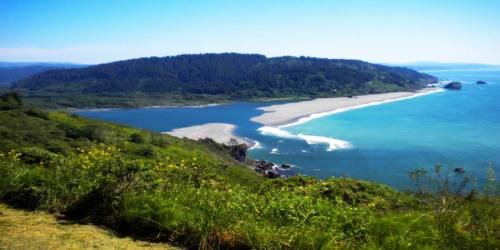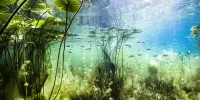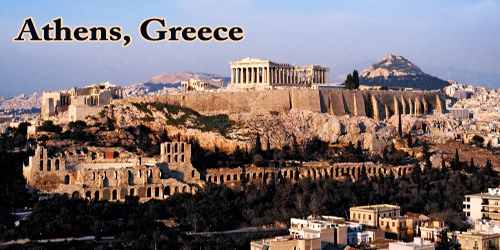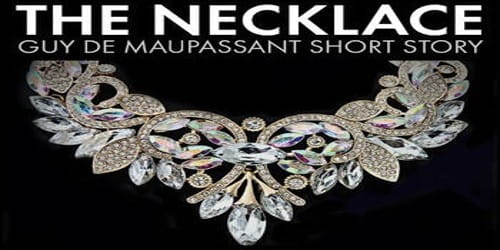Redwood National and State Parks reside (RNSP), are a complex of several states and national parks located in the United States, along the coast of northern California. It was established in 1968, with a boundary change in 1978, and was designated a World Heritage Site in 1980. Preserving virgin (old-growth) groves of ancient redwood trees, including the world’s tallest tree, the park also features 40 miles (64 km) of scenic Pacific coastline. It covers an area of 172 square miles (445 square km) of which more than one-third is old-growth forest and includes land held in three state parks: Jedediah Smith Redwoods, Del Norte Coast Redwoods, and Prairie Creek Redwoods (dating from the 1920s).
Located entirely within Del Norte and Humboldt Counties, the four parks, together, protect 45% of all remaining coast redwood (Sequoia sempervirens) old-growth forests, totaling at least 38,982 acres (157.75 km2). These trees are the tallest, among the oldest, and one of the most massive tree species on Earth. In addition to the redwood forests, the parks preserve other indigenous flora, fauna, grassland prairie, cultural resources, portions of rivers and other streams, and 37 miles (60 km) of pristine coastline.

The national park (and state parks) stretches along the California coast from Crescent City, headquarters of the national park, south past the mouth of the Klamath River to the environs of the town of Orick. Sea lions and harbour seals live offshore; bald eagles, doubled-crested cormorants, and endangered California brown pelicans glide above the ocean beaches and sea cliffs; and farther inland summer fog provides additional moisture for the redwood forests. Although there are black bears in the park, the Roosevelt elk is the most commonly seen wild mammal. Other wildlife includes coyotes, bobcats, blacktail deer, chipmunks, and squirrels.
In 1850, the old-growth redwood forest covered more than 2,000,000 acres (8,100 km2) of the California coast. The northern portion of that area, originally inhabited by Native Americans, attracted many lumbermen and others turned gold miners when a minor gold rush brought them to the region. Failing in efforts to strike it rich in gold, these men turned toward harvesting the giant trees for booming development in San Francisco and other places on the West Coast. After many decades of unrestricted clear-cut logging, serious efforts toward conservation began.
By the 1920s the work of the Save the Redwoods League, founded in 1918 to preserve remaining old-growth redwoods, resulted in the establishment of Prairie Creek, Del Norte Coast, and Jedediah Smith Redwoods State Parks among others. Redwood National Park was created in 1968, by which time nearly 90% of the original redwood trees had been logged. The National Park Service (NPS) and the California Department of Parks and Recreation (CDPR) administratively combined Redwood National Park with the three abutting Redwood State Parks in 1994 for the purpose of cooperative forest management and stabilization of forests and watersheds as a single unit.
The park is covered with a magnificent forest of coastal redwood trees, the tallest and most impressive trees in the world. The marine and land life are equally remarkable, in particular the sea lions, the bald eagle and the endangered California brown pelican. The ecosystem of the RNSP preserves a number of threatened animal species such as the tidewater goby, Chinook salmon, northern spotted owl, and Steller’s sea lion. In recognition of the rare ecosystem and cultural history found in the parks, the United Nations designated them a World Heritage Site on 5th September 1980 and part of the California Coast Ranges International Biosphere Reserve on 30th June 1983.
Weather in RNSP is greatly influenced by the Pacific Ocean. Coastal temperatures generally range between 40 and 60 degrees Fahrenheit (4-15 °C) all year round, while further from the coast summers are hotter and drier, and winters are colder. Redwoods mostly grow a mile or two (1.5-3 km) from the coast, and never more than 50 miles (80 km) from it.
The coast redwood (Sequoia sempervirens), which is found in the park, is fast-growing and among the longest-lived species on earth (living an average of 600 years); it is also the tallest of the world’s trees. In 1963 a redwood called “Tall Tree,” located on Redwood Creek in Tall Trees Grove in the southern section of the park, was measured at 367.8 feet (112.1 metres) tall (although its top broke off later) and had a diameter of 14 feet (4 metres). Though reduced in extent by commercial logging, which continues today outside the park, redwoods can live as long as 2,000 years, protected from fire by their thick, sapless bark.
When western expansion met the redwoods in the 1800s, the trees began to fall under saw and ax. The massive redwoods offered early settlers a seemingly inexhaustible lumber supply. However, within a hundred-year span, the vast forests were reduced to a fraction of their former range. By the early 1900s, it was apparent that the future of the old-growth redwood forest was in doubt.
The park’s primary feature is the coastal redwood forest, a surviving remnant of the group of trees that has existed for 160 million years and was once found throughout many of the moist temperate regions of the world, but is now confined to the wet regions of the west coast of North America. The park contains some of the tallest and oldest known trees in the world. Rich intertidal, marine and freshwater stream flora and fauna are also present in the two distinctive physiographic environments of coastline and coastal mountains that include the old-growth forest and stream communities.

Currently, there are over 200 exotic species known to live in Redwood National and State Parks. Of these thirty have been identified as invasive species, ten of these are considered threats to local species and ecosystems. Exotic species currently account for about a quarter of the total flora in the parks. Only about one percent of plant growth in old-growth areas are of exotic species, while areas such as the Bald Hills prairies have a relative cover of fifty to seventy-five percent exotic. The type of foreign vegetation also varies, with plants such as the English Ivy (Hedera helix), Spotted Knapweed (Centaurea maculosa), and the Poison Hemlock (Conium maculatum). The spotted knapweed and poison hemlock are both under consideration for addition to a high priority watch list maintained by the park system.
The best places for visitors to base themselves are in Crescent City, at the north end of the park system, or in Arcata, to the south of the parks. Many of the best hikes are centered almost midway between these two towns, in the Prairie Creek Redwoods State Park. Crescent City is best if visitors are interested in exploring the hikes and sites of Jedediah Smith Redwoods State Park. Arcata may be a better choice if they want to set their sights on the southern parks.
Information Sources:
















